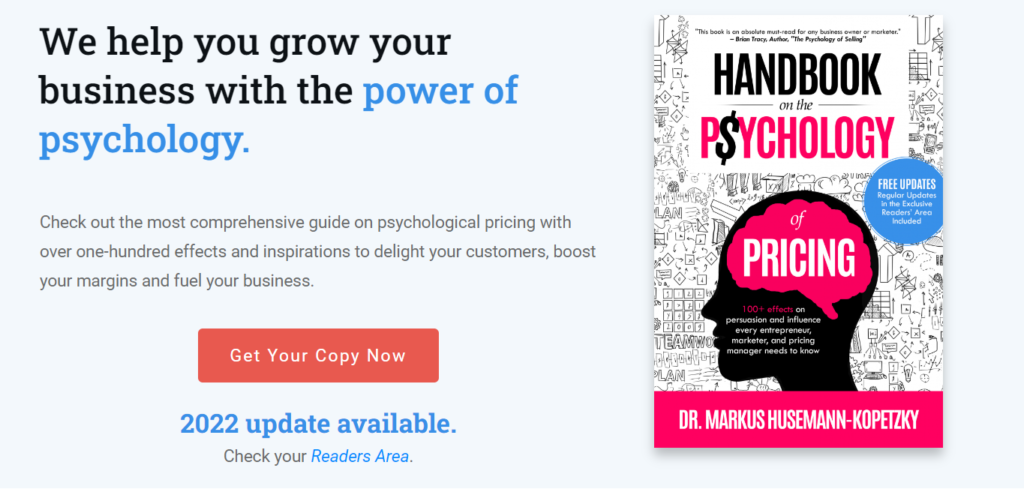How to set up an effective pricing strategy in online retail? Interview with Dr. Markus Husemann-Kopetzky
- 03 August 2023
“Without discussing pricing performance among the top-level managers, required actions to steer pricing do not become salient” – says Dr. Markus Husemann-Kopetzky, an expert in pricing. In the exclusive interview for Dealavo, he explains how to initiate, set up and evaluate the pricing strategy in online retail. He shares information about the most relevant psychological effects that impact pricing and profit.
Dealavo: How to initiate a process of effective price management? What tools and data should companies start with?
Markus Husemann-Kopetzky: Pricing in retail and e-commerce has four characteristics:
- many price decisions for large assortments,
- a high frequency of price changes,
- interdependencies between products,
- heterogeneity in price relevance from a customer’s perspective across the assortment.
These characteristics mean that retailing and e-commerce companies have to make countless pricing decisions, and each decision requires data and logic that a single Excel sheet usually cannot process. My recommendation for pricing in retail and e-commerce is “infrastructure first, intelligence second.” I suggest that companies first start with a solid technical foundation that can: process pricing decisions on a scale (i.e., price automation), and optimize prices based on data science (i.e., combining pricing rules with machine learning for price optimization).
The good news is that there are so many standard pricing software solutions available that developing a pricing tool in-house is most often the inferior option (given the actual and opportunity costs for developers). The question for retailers is only which pricing software fits our situation best.
When the pricing software is set up, retailers usually feed it with four basic categories of data:
- product information,
- procurement costs,
- RRP,
- competitor pricing data
– to configure a first set up pricing rules. Furthermore, for each product category, retailers set parameter values for target margins and define a maximum price distance to competitor prices.
Taking pricing to the next level, retailers and e-commerce companies can add a plethora of data. Three common extensions are transactional data (to train ML models), assortment classification on product level (“article role”), and category level (“pricing cluster”) (i.e., differentiation by the relevance of prices from a customer’s perspective to determine the company’s pricing leeway), product relationships (e.g., product variants, product sets, product size variations).
What are the top three factors to consider when deciding on a pricing strategy? What should companies take into account before they start using the dynamic pricing tool?
The pricing strategy is the plan to deliver on specific pricing objectives. These pricing objectives usually combine:
- the expected contribution of pricing to a company’s financial goals,
- the company’s target (brand) positioning relative to the competition,
- their customers’ price image perception.
When the (online) retailer has made decisions on its pricing objectives and derived the pricing strategy, they are well prepared to define smart pricing tactics and configure intelligent pricing mechanisms to deliver on the plan.
How can you determine whether a company has a well-thought-out pricing strategy?
The pricing strategy is only one building block when it comes to effective price management and delivering on company goals. Besides the pricing strategy, we usually look at the strategy for pricing. Our pricing framework considers ten dimensions and evaluates respective questions:
- Pricing Strategy: How does the pricing strategy consistently support the overall corporate strategy?
- Pricing Inputs: To which degree are required pricing input data and information available?
- Price Setting: How are the mechanisms – from heuristics and rules to machine learning and mathematical optimization – behind price decisions designed?
- Price Augmenting: How is the price of a product enriched by additional information – such as the “price-per-unit” information or the recommended retail prices – to put the price into context?
- Price Publishing: How are prices presented and communicated across customer touchpoints (i.e., is the presentation consciously designed and psychologically optimized)?
- Experiments & Simulations: What are the capabilities of running experiments on prices and price presentations? How are decisions about prices informed before implementing price changes (i.e., simulating the – financial – effect of price changes ex-ante)?
- IT & Data Management: To which degree does the availability of data and the underlying infrastructure (pricing software, adjacent analytic systems) efficiently and effectively support price management?
- Organization & Skills: How are the relationships between teams involved in pricing and underlying processes designed? How is the level of qualification and continuous development managed within the pricing function?
- Regulatory Compliance: What are the inherent legal and reputational risks associated with prices (e.g., presenting incorrect strikethrough prices)?
- Price Controlling & Price Performance: How is the performance of pricing measured (from steering concept to KPIs) and managed across all levels of the organizational hierarchy (e.g., implemented in management dashboards and business reviews)?
Reviewing these ten blocks in the pricing framework provide a nuanced answer to the questions: (a) Where do we stand? (b) Out of the many levers in price management that we can pull on, which ones should we focus on now? (c) And which pricing project has the highest leverage, and should we start next?
What are the most common pricing mistakes that companies make?
Most frequently, I come across three mistakes that retailing companies make:
- Methodologically, it is applying undifferentiated cost-plus pricing.
In 2023, many companies still set prices by adding a target margin to their procurement prices. In light of financial goals, setting prices in this way might be intuitive. But this approach to pricing does not reflect the customers’ importance of prices in their buying decision and their price acceptance, so it leaves money on the table. For some items, the price is not sufficiently sharp (KVIs); for others, the price does not fully utilize the pricing leeway. Moving from cost-plus pricing, first, to simple and complex pricing rules that consider the customers’ perspective and then, second, to adding the power of machine learning to replace “magic numbers” (such as target margins or price distances to competitors) with mathematically derived optimal values might be the development path to follow. - Data-wise, it is not having the breadth and depth of price input data. Two sources of data are both important and, most often, not ideal.
First, competitor pricing data is a key ingredient to pricing for retailers and e-commerce companies. Simulating the various price points that customers might consider when making their buying decisions is crucial – for branded products, but also for private label products. Competitor web-crawling data can also add many more insights to support various use cases (e.g., information about the availability of products, assortment expansions & contractions over time, longitudinal price changes, product data & strikethrough prices, promotional tags & banners). Many companies have not fully utilized the power of available competitor information for their decisions about regular prices, promotional prices, and other domains, such as strategic assortment expansions.
Second, product information, particularly the relationships between different SKUs (i.e., EANs, GTINs, UPCs), are in many cases – what is the right word? – a mess. Category and pricing managers have no information about which EANs are (1) variants (e.g., the same product in different colors or flavors), (2) quantity variants (e.g., single container but in different sizes – e.g., 500 grams vs. 1 kilogram), (3) promotional quantity variants (e.g., 500 grams vs. 500 grams + 20% extra = 600 grams), (4) pure bundle variants (e.g., the same product in different bundles, e.g., single bottle vs. 24 bottles in a case), (5) mixed bundle variants (e.g., six razor blades vs. six razor blades plus shaver) (6) quality variants (e.g., good, better, best), (7) parts of the same product series (e.g., washcloth, small towel, large towel or switch, outlet, frame), or (8) sets of individually available products (e.g., four chairs and one table). Without data about relationships between items, price inconsistencies in the assortment are guaranteed. - In terms of steering, senior management keeps pricing a domain on an operational level.
Pricing objectives and pricing performance should be included consistently in all relevant business reviews (from WBRs and MBRs to QBRs and ABRs) up to the senior management boards. Without discussing pricing performance among the top-level managers, required actions to steer pricing do not become salient. Furthermore, without senior management attention, the responsible pricing executive or pricing team does not receive the mandate to enlist sufficient support in the company to create traction on key pricing initiatives.
How does price management differ during times of recession compared to times of prosperity?
The current recessionary times combine an economic downturn with high inflation rates. Consumers become more conscious about spending, want to feel like “smart shoppers,” and become fearful about their financial future. This change in customer behavior concurs with substantial changes to procurement prices. To make the context even more dynamic, the same situation also happens to competitors that react with more frequent price changes across a larger part of their selection.
Although company objectives might change from revenue growth to maintaining cashflows, processes, and capabilities in price management in recessionary times do not necessarily change per se – but mistakes become more costly when liquidity is under pressure.
Retailing companies need to learn to unlearn what has worked in the past and to react intelligently to the new environment – for example, by answering questions like:
- How do changes to customer behavior affect individual article roles (e.g., what are new KVIs? How does the importance of private label vs. branded products change? How is the price entry, mid-price, and premium price segment impacted?)?
- For which parts of the assortment should we lower, keep, or increase prices by which degree?
- Do we receive competitor prices on time so that we are not unintentionally uncompetitive or unnecessarily price-leading?
- Should we retrain our forecasting and price-optimizing models?
- What are the new psychological price thresholds? By how far can we exceed existing price thresholds?
- How should we adjust our markdown pricing and price promotions?
- How can we leverage price communication to cater to customers’ need to feel like “smart shoppers”?
What is the best strategy for manufacturers that want to sell D2C but also keep good relationships with their distributors? How should they manage pricing in their e-shop?
When implementing a D2C strategy, the pricing strategy for the (new) D2C channel is important, but only one key dimension when setting up a new, owned channel in addition to existing third-party retail channels. You need to consider at least three factors and answer three questions:
- What is the story for each channel?
To create a non-competing context for each channel, you need to carve out a rationale for why each channel exists and what the individual selling proposition is. For example, you might offer unique parts of the assortment to various channels. - What is the customer experience in each channel?
The various price points for a comparable or overlapping selection across retailing and D2C channels are an important dimension of the customers’ experience. For which parts of the assortment do you strive for price parity? When do you set higher D2C prices (e.g., at RRP/MSRP) to keep the quality perception up? When do you undercut retail partners’ prices (e.g., to manage inventory levels or consciously price aggressively relative to competing brands?) To successfully implement a D2C channel, manufacturers need to discuss these decisions upfront. - How do we make the sum of two channels greater than their individual parts?
The most important question is how to create a customer experience with the new D2C channel that delivers more value to customers. Thereby, the overall attractiveness of the brand increases, leading to more sales for retailers and the D2C channel. The rationale is to move from the perception of a zero-sum game across channels to creating synergy effects that all channels benefit.
You wrote a book about the psychology of pricing. Do customers make more rational decisions when shopping online than in physical stores?
Customers apply the same “mental apparatus” when shopping online or offline. When shopping online, the “costs” for price searches are much smaller than for shopping offline (“just a click away”). Therefore, online shoppers integrate more information and benefit from greater price transparency than offline shoppers. In addition, the switching costs are substantially higher when shopping offline. Assuming an offline customer checks the price for an article online and finds out that he needs to drive 10 km to another store or wait two days for delivery when ordering online to save $10, he might not invest the effort. This behavior is 100% rational, although the customer would decide to pay $10 more.
Overall, the same psychological heuristics and biases affect online and offline buying decisions in the same way.
In your opinion, which psychological effect holds the greatest importance for pricing managers?
Based on research and empirical data, three psychological effects have a pronounced effect relevant for pricing managers.
First, external reference prices (e.g., RRP/MSRP) serve as anchors that raise the internal reference price for customers (“anchoring effect”). Therefore, selling prices that are lower than a strikethrough-price become more attractive for customers than those without this context.
Second, the compromise effect explains that customers tend to choose the easier-to-justify middle option and avoid the lower-end or higher-end, extreme option. Helping customer justify their purchases to an imaginary third person has a profound effect on customers’ buying decisions. In doubt, offer customers three options, and add a third, high-end option if two options already exist. This new high-end version might draw demand from the first to the second (middle) option, although it is itself not relevant for customers (so-called “decoy”).

Source: https://psychologyofpricing.com/
Third, on the design of promotions, a plethora of research investigated the effects of different promotional formats on customer behavior relative to direct price reductions. Given the substantial impact of promotions on financials, creating promotional formats that deliver the same attractiveness and sales uplift but at lower costs – i.e., delivering a higher promotional ROI – is important for pricing managers.
For more inspiration on psychological pricing or pricing in general, I suggest checking out PricingNuggets.com and the “Handbook on the Psychology of Pricing,” which references more than 100+ psychological pricing effects to start with.
About Dr. Markus Husemann-Kopetzky
Dr. Markus Husemann-Kopetzky is a researcher, thought leader, and advisor in the field of marketing and pricing. He founded the Price Management Institute, a consultancy that promotes price management in (online) retailers, and published in leading academic journals like the Journal of the Academy of Marketing Science, Journal of Marketing Behavior, and Marketing Letters as a Guest Researcher at the Freie Universität Berlin, Germany. European Pricing Platforms calls him “one of the most important pricing influencers in Europe.




